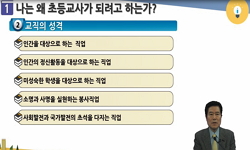Learners’ Mindset When Methods Are Different in Peer Learning that Targets Native Korean Learners - Focused on learning space and grouping - Ishizuka Ken This study conducted a survey to clarify how different learning spaces (or classrooms) and grou...
http://chineseinput.net/에서 pinyin(병음)방식으로 중국어를 변환할 수 있습니다.
변환된 중국어를 복사하여 사용하시면 됩니다.
- 中文 을 입력하시려면 zhongwen을 입력하시고 space를누르시면됩니다.
- 北京 을 입력하시려면 beijing을 입력하시고 space를 누르시면 됩니다.

韓国語母語話者を対象としたピア․ラーニングにおける学習形態の違いに対する学習者の意識 - 教室空間とグループ編成を中心に - = Learners’ Mindset When Methods Are Different in Peer Learning that Targets Native Korean Learners - Focused on learning space and grouping -
한글로보기https://www.riss.kr/link?id=A104010045
-
저자
이시즈카 켄 (동국대학교 경주캠퍼스 일어일문학과 강의초빙교수)

- 발행기관
- 학술지명
- 권호사항
-
발행연도
2017
-
작성언어
Japanese
-
주제어
ピア․ラーニング ; 協同学習 ; 学習空間 ; 学習者の意識 ; グループ編成 ; Peer-Learning ; Cooperative Learning ; Learning spaces ; Mindset of learner ; Grouping ; Peer-Learning ; 협동학습 ; 학습공간 ; 학습자의 의식 ; 그룹편성
-
등재정보
KCI등재
-
자료형태
학술저널
-
수록면
257-273(17쪽)
-
KCI 피인용횟수
2
- DOI식별코드
- 제공처
-
0
상세조회 -
0
다운로드
부가정보
다국어 초록 (Multilingual Abstract)
Learners’ Mindset When Methods Are Different in Peer Learning that Targets Native Korean Learners - Focused on learning space and grouping - Ishizuka Ken This study conducted a survey to clarify how different learning spaces (or classrooms) and grouping (or pair) methods of peer learning affect the mindset of a learner. Also, an interview was carried out to add a qualitative factor. In the three different class types of uniform learning, ‘ㄷ,’ and a fixed group, a Japanese class with a peer learning concept was given, and then the survey and the interview were conducted. Before the survey, a preliminary survey was conducted to identify the learner’s tendency and to set questions.
In the uniform types of learning classroom, learners freely choose seats and members to do assignments with, but they normally do activities with the same members. They accept positively that they can study both in the seats and with the friends they like, but from the perspective of peer learning, only a few pairs or groups achieve effective learning. Intimacy reduces psychological anxiety, but it is hard to balance language level or motivational differences between group members, so this method is effective on only a portion of learners.
In the ‘ㄷ’ type of classroom, a sense of unity, partner diversity, and novelty are accepted positively, but it has a negative impact on building relationships with partners. The survey result shows that it is better to have the same partners for a certain period, rather than to have a new partner in every class. Also, having a teacher to choose partners, who knows the readiness of the learners (*readiness refers to a learner’s information such as one’s learning maturity, the learner’s condition, or the learning environment), gives more balanced learning pairs.
In the fixed group types of classroom, the learners accepted this method positively from the perspective of interactive learning. Not only was their own Japanese learning stimulated through activities with other members, but it also clearly showed that the burden on learners was reduced. However, it became clear that motivation, cooperation, and appropriate level differences in the group members are the necessary conditions to achieve those effects. Even from a conductor’s point of view, this type can control both small and large groups; it is expected to be one of the most effective learning space methods in peer learning.
참고문헌 (Reference)
1 石塚健, "韓国語母語話者の学習者を対象としたピア·ラーニングにおけるレベル別の学習者の学びに対する意識 - 上級者の学びを中心に -" 대한일어일문학회 (69) : 177-193, 2016
2 이시즈카 켄, "韓国語母語話者の学習者を対象としたジグソー学習法による読解授業の試み" 대한일어일문학회 (44) : 183-201, 2009
3 石塚建, "韓国語母語話を対象にしたピア․ラーニングにおけ るペアおよびグループ内の問題の実態と学習意識 - インタビュー調査を中心に -" 동북아시아문화학회 1 (1): 285-304, 2016
4 房賢嬉, "韓国人中級日本語学習者を対象とした発音協働学習の試み-発音ピア․モニタリング活動の可能性と課題―" 日本語教育学会 (144) : 157-168, 2010
5 李英淑, "韓国の高校における作文授業の現状と改善策-済州外国語高等学校でのピア推敲活動を通して-" 日本言語文化研究会 (4) : 33-60, 2008
6 安永悟, "活動性を高める授業づくり -協同学習のすすめ"
7 広瀬和佳子, "母語によるピア․レスポンス(peer response)が推敲作文におよぼす効果-韓国人中級学者を対象とした3ヶ月間の授業活動をとおして-" お茶の水女子大学日本言語文化学研究会お茶の水女子大学 (19) : 24-37, 2000
8 貸し会議室情報局, "座席の配置で会議が変わる!?あなたの会議に最適なレイアウトは?"
9 安永悟, "実践․LTD話し合い学習法" ナカニシヤ出版 64-70, 2006
10 ジョンソン, "学生参加型の大学授業-協同学習への実践ガイド" 玉川大学出版部 144-145, 2001
1 石塚健, "韓国語母語話者の学習者を対象としたピア·ラーニングにおけるレベル別の学習者の学びに対する意識 - 上級者の学びを中心に -" 대한일어일문학회 (69) : 177-193, 2016
2 이시즈카 켄, "韓国語母語話者の学習者を対象としたジグソー学習法による読解授業の試み" 대한일어일문학회 (44) : 183-201, 2009
3 石塚建, "韓国語母語話を対象にしたピア․ラーニングにおけ るペアおよびグループ内の問題の実態と学習意識 - インタビュー調査を中心に -" 동북아시아문화학회 1 (1): 285-304, 2016
4 房賢嬉, "韓国人中級日本語学習者を対象とした発音協働学習の試み-発音ピア․モニタリング活動の可能性と課題―" 日本語教育学会 (144) : 157-168, 2010
5 李英淑, "韓国の高校における作文授業の現状と改善策-済州外国語高等学校でのピア推敲活動を通して-" 日本言語文化研究会 (4) : 33-60, 2008
6 安永悟, "活動性を高める授業づくり -協同学習のすすめ"
7 広瀬和佳子, "母語によるピア․レスポンス(peer response)が推敲作文におよぼす効果-韓国人中級学者を対象とした3ヶ月間の授業活動をとおして-" お茶の水女子大学日本言語文化学研究会お茶の水女子大学 (19) : 24-37, 2000
8 貸し会議室情報局, "座席の配置で会議が変わる!?あなたの会議に最適なレイアウトは?"
9 安永悟, "実践․LTD話し合い学習法" ナカニシヤ出版 64-70, 2006
10 ジョンソン, "学生参加型の大学授業-協同学習への実践ガイド" 玉川大学出版部 144-145, 2001
11 杉江修治, "大学授業を活性化する方法" 玉川大学出版部 132-134, 2004
12 杉江修治, "協同学習入門 基本の理解と51の工夫" ナカニシヤ出版 1-, 2011
13 エリザベス, "協同学習の技法 大学教育の手引き" ナカニシヤ出版 33-41, 2009
14 関山聡之, "ペアを固定化したピア․レスポンスに対するビリーフ調査-韓国語母語話者の場合-" 日本比較文化学会 (89) : 93-104, 2009
15 이시즈카 켄, "ピア・リーディングによる読解授業の問題点を探る -JFL環境で学ぶ韓国語母語話者の学習者を対象とした実践を通して-" 대한일어일문학회 (47) : 171-187, 2010
16 田中信之, "ピア․レスポンスにおける話し合い-話し合いの言語とグループ編成についての考察-" 北陸大学 (31) : 201-211, 2007
17 池田玲子, "ピア․ラーニング入門-創造的な学びのデザインのために" ひつじ書房 5-8, 2007
18 Y.シャラン, "「協働」による総合学習の設計-グループ․プロジェクト入門―" 北大路書房 47-49, 2001
19 이시즈카 켄, "JFL環境の韓国語母語話者の学習者を対象としたピア・レスポンスの研究 - 質問紙調査の分析から見る協働学習の成功要因と授業デザインの可能性 -" 동북아시아문화학회 1 (1): 423-446, 2009
20 이시즈카켄, "JFL環境の韓国人学習者を対象としたピア․レスポンスの研究 - 話し合いの言語およびグループを中心に -" 동북아시아문화학회 1 (1): 75-92, 2012
21 이시즈카 켄, "JFL環境の韓国人学習者を対象としたピア․レスポンスの研究 - ビリーフ調査および中国人学習者との比較 -" 동북아시아문화학회 1 (1): 451-467, 2011
22 石塚健, "JFL環境の韓国人学習者を対象としたピア․レスポンスにおける学習者の意識の研究 -グループ内のレベル差の観点から-" 동북아시아문화학회 1 (1): 285-302, 2015
동일학술지(권/호) 다른 논문
-
예술흥행비자(E-6) 소지 이주여성에 대한 인신매매행위 대응정책의 문제점과 개선방안
- 동북아시아문화학회
- 이병렬(Lee, Byung-Ryul)
- 2017
- KCI등재
-
- 동북아시아문화학회
- 문재원(Mun, Jae-Won)
- 2017
- KCI등재
-
성장곡선 모형을 활용한 일본 등 최고기술보유국과 한국 기술수준평가에 관한 비교연구
- 동북아시아문화학회
- 김완민(Kim, Wan-Min)
- 2017
- KCI등재
-
- 동북아시아문화학회
- 權奇洙(Kwon, Gi-Su)
- 2017
- KCI등재
분석정보
인용정보 인용지수 설명보기
학술지 이력
| 연월일 | 이력구분 | 이력상세 | 등재구분 |
|---|---|---|---|
| 2026 | 평가예정 | 재인증평가 신청대상 (재인증) | |
| 2020-01-01 | 평가 | 등재학술지 유지 (재인증) |  |
| 2017-01-01 | 평가 | 등재학술지 유지 (계속평가) |  |
| 2015-03-17 | 학회명변경 | 영문명 : 미등록 -> The Association of North-East Asian Cultures |  |
| 2013-01-01 | 평가 | 등재학술지 유지 (등재유지) |  |
| 2010-01-01 | 평가 | 등재학술지 유지 (등재유지) |  |
| 2007-01-01 | 평가 | 등재학술지 선정 (등재후보2차) |  |
| 2006-01-01 | 평가 | 등재후보학술지 유지 (계속평가) |  |
| 2004-07-01 | 평가 | 등재후보학술지 선정 (신규평가) |  |
학술지 인용정보
| 기준연도 | WOS-KCI 통합IF(2년) | KCIF(2년) | KCIF(3년) |
|---|---|---|---|
| 2016 | 0.46 | 0.46 | 0.43 |
| KCIF(4년) | KCIF(5년) | 중심성지수(3년) | 즉시성지수 |
| 0.41 | 0.37 | 0.629 | 0.09 |




 KCI
KCI





